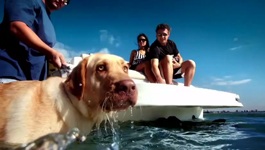Boating Lifestyle
Boating Lifestyle
There is so much to love, and learn, about boating. That's why we created this library of articles, videos and blog posts to help you throughout your adventures.
When to Fish

When to Fish
Experienced anglers will tell you that there ARE best times to fish. These best times can be related to the amount of sunlight, to warming trends, to depth at which fish are found, to storm and weather patterns, to wind, and to tidal flows when saltwater fishing. Thus, WHEN to fish can also affect and be affected by WHERE to fish. Too many hot days during the summer can adversely affect fishing in shallow lakes, ponds, and rivers since the higher water temperatures can reduce oxygen in the water and cause fish to become sluggish.
VARIABLE WEATHER PATTERNS
Wind
Wind can play a large role in fishing success. Wind pushes bait to the far shore, with bait followed by game fish. If fishing from shore on a windy day, fish where you have to cast into the wind. If fishing from a boat, cast with the wind on a sheltered shore.
Fronts
Storms and changing weather patterns affect fishing success since fish are keenly attuned to changes in barometric conditions. With many fish, feeding increases during the hours immediately before a cold front, but slows during and after a storm or front hits. Fishing after a cold front is poor and continues to be poor for a day or two.
Warm fronts cause surface water temperatures to increase. Such fronts often put fish into a feeding mode. This can be particularly true in the winter, when a warming trend can cause otherwise sluggish fish to start feeding actively. Most of this feeding activity is on or near the warm surface.
Cloud Cover
Cloudy days improve fishing since the clouds prevent light penetration. Overcast skies cause fish to cruise for food more than they would during bright days when they tend to hide and stay close to structure. On overcast cloudy days, fish are less likely to be on specific structure spots or areas and more likely to be scattered throughout a waterway.
Rain
Another good time to fish is during a light rain, especially a warm spring or summer rain. Rain can help you hide from the fish since the rain breaks up the view that the fish has through the water surface. This is true whether shore, wade or boat fishing. Rain also washes insects and bait into the water, with this extra food creating a feeding binge for fish. Warm rains quickly warm the water to cause these feeding periods.
Hard rain conditions are a poor time to fish since heavy rains can muddy the water, make it difficult for fish to find bait or lures, and also cause heavy runoff which can clog their gills. The increased water flow in rivers from any rain increases current flow and makes it difficult for fish to maintain a comfortable position in the river. High water levels can also create rapids, waves and unsafe fishing conditions. If there is any lightning or possibility of lightning, you must get off of the water in your boat or immediately away from the water if wading or fishing from the shore. Safety must come first in any fishing situation.
SALT WATER AND TIDES
Saltwater Tides
In salt water, tides affect water level so that a shallow area that might hold fish and be a very good spot to fish during a high tide might be a bare mud bank during low tide conditions. Similarly, a slough – a slight depression in the bottom - that might be perfect for bottom feeding fish during a low tide situation might be too deep and difficult to fish on a high tide. Running tides (rising or falling) are best since they cause bait to move and provoke active feeding among coastal fish.
Brachish Water Tides
Checking changing tides and the best times and areas to fish is also important when fishing in brackish water – coastal water that is a mix of salt and fresh, yet still affected by tides. Brackish water is found in most tidal creeks and rivers along all coasts and can affect both saltwater and some freshwater species.
Planning Ahead
Since tides and movements are so important in saltwater and brackish water fishing, check for daily tide information in your local newspaper or at your local fishing shop. Tides raise and lower the water level approximately two times per day and affect where fish are located and how they feed. The timing of a high or low tide changes daily and is also different for each coastal area. The best fishing is almost always on a rising or falling tide – not the dead low or dead high when there is little or no water movement.
Determining the best time to fish requires checking on many fishing factors and outdoor conditions. The key to fishing success is to learn about fish and how they live. Try different tactics in your fishing to make each day of fishing a great day.
Courtesy of www.takemefishing.org


